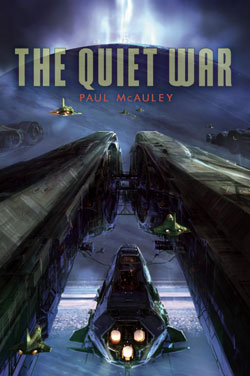
The Quiet War thinks people are no damn good. It’s set a couple of hundred years in the future and citizens of human colonies on the moons of Saturn are evolving themselves into posthumans. This is a common theme in SF. One of the genre’s ongoing projects is an expansion of the definition of “human.” But most people back on The Quiet War’s Earth would rather not have their definition expanded, and the more radically posthuman colonists think unmodified humans are uncouth genetic throwbacks.
Late in the book one character talks about ring species. Ring species are unusual species which trick you into watching a creepy videotape and then, seven days later, jump out of your television. No, wait. Actually, ring species are species which live in a ring-shaped habitat. At the two ends of the ring are distinct species, so different they can’t interbreed, but in between are a series of interbreeding populations, each a little different, gradually shading into the two species on the ends.
The Quiet War sees humanity defining itself as this kind of continuum, othering the ends of the continuum, and declaring war.
The thing is, Earth and the colonies don’t know why they’re going to war. The powers that be—the monarchical families that rule earth, and the influential personalities who guide public opinion in the direct democracies of the colonies—think they’re going to war for revenge, for resources, for philosophical differences, or for control of the solar system. But at bottom, they’re going to war because even the leaders who have the people under their thumbs are themselves under the collective thumb of the mob… and the mobs hate each other’s guts.
No matter where you are in the solar system, humanity in The Quiet War gets meaner and stupider in the aggregate. And it won’t stop with one war: wipe out the people at the ends of the ring, and the people left in the smaller ring redefine the new ends as not quite human. Repeat the process long enough, and there’s not much of humanity left.
So, yeah, grim. And not necessarily what I needed to read coming out of winter. (Could we please have more SF about cool futures? You know, where most people are basically going to be okay? It’s not like an utter dystopia is a necessary prerequisite for conflict and drama.) It didn’t help that of the five point-of-view characters, four were, as far as I was concerned, villains.
But I still read the whole thing—enough to find out that, luckily, the single sympathetic POV character gets a happy ending, and most of the few other characters I cared about made it through all right. The Quiet War is a decent thriller. Paul McAuley’s prose isn’t earth-shatteringly beautiful—what I look for in prose are “I never thought of it that way” moments, the bits where some observation, word choice, or turn of phrase makes me think of whatever’s being described in a new light. But The Quiet War isn’t badly written, either; it’s what readers suspicious of highfaultin’ lit’ry stuff call “transparent prose,” and a better than average example of the form.
If The Quiet War has a problem, it’s that McAuley is sometimes too anxious to show us his research. Technical detail is good—this is hard SF, after all—but McAuley gave more detail than I needed, or cared, to know. A small, typical example occurs in a battle scene when a dead soldier’s body is frozen to be sent home. McAuley is careful to inform us that he’s frozen at two degrees Celsius. Why do we need to know the exact temperature? You could slim this thing down by fifty pages, and be left with a better book, just by cutting the excess technobloviation.